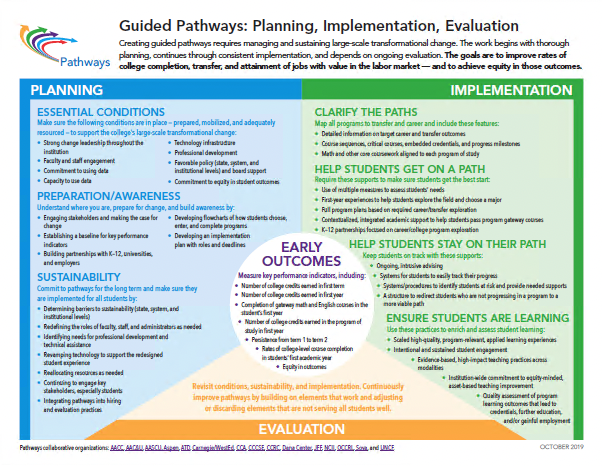
GUIDED PATHWAYS TO STUDENT ENGAGEMENT, LEARNING, AND COMPLETION
With Equity in Student Outcomes
The Center for Community College Student Engagement has long advocated efforts to strengthen community college education in ways that lead to increased college completion and equity in student outcomes. Learning from the Center’s survey research and student focus groups, as well as through important work from the Community College Research Center and other organizations, has produced the understanding that substantial improvement in these areas cannot be attained through small-scale strategies or interventions but only through fundamental redesign of students’ educational experiences. From that learning emerged the escalating movement among community colleges committed to the design and implementation of guided pathways—at scale, for all students.
Guided Pathways Essential Practices
Colleges undertaking guided pathways reforms will focus redesign efforts in four areas, briefly described below:
Clarify Paths to Student End Goals. Central to guided pathways reform is the design of clear, educationally coherent pathways for students. Colleges will:
- Simplify students’ choices with default program maps developed by faculty and advisors, depicting clear pathways to completion, further education, and employment in fields of importance to the region.
- Establish transfer pathways through alignment of pathway courses and expected learning outcomes with transfer institutions, optimizing applicability of community college credits to university majors.
- Align high school pathways, including dual credit courses and student learning outcomes, with community college certificate and degree programs.
Help Students Get on a Path. Pathways colleges redesign the student onboarding process, with emphasis on these steps:
- Provide career information and support for career decisions as students enter college, refine their choices during the first academic term, and develop a full-program educational plan.
- Redesign traditional remediation to integrate academic skill building into students’ pathways, aligning math and other academic skills development with a student’s program of study, contextualizing instruction to build academic and non-academic skills throughout the college-level curriculum, and ensuring that students complete college-level math and English in the first academic year.
Help Students Stay on Their Path. Once on a clear pathway, students benefit as their colleges implement systems to:
- Support students through strong advising throughout the pathway experience, helping students make informed choices, promoting clarity about transfer and career opportunities, monitoring progress on students’ educational plans, and intervening when they go off track.
- Embed academic and non-academic supports throughout students’ programs to promote learning and persistence.
Ensure Students Are Learning. To promote excellence in teaching and learning within all program pathways, colleges will:
- Establish an institution-wide commitment to equity-minded, asset-based teaching improvement.
- Establish program-level learning outcomes aligned with the requirements for success in employment and further education in a given field; apply results of learning outcomes assessment to improve instructional effectiveness.
- Integrate experiential/applied learning and other active/collaborative learning approaches to enhance instruction and student success in courses across programs of study.
- Ensure that every student participates in a program-related “light-my-fire” course in their first academic term.
- Incorporate effective teaching practice—student engagement—throughout the pathways.

Focus on Learning: Critical Faculty Work
Beautifully designed curricular pathways and greatly improved intake and advising systems will make little difference unless colleges commit also to a central focus on the quality of learning within their guided pathways model. While the work will appropriately vary across meta-majors and disciplines, there are important shifts to consider. Faculty will find that instead of working in isolation, they will be called upon to work in collaboration with program faculty colleagues, advisors, and other student support personnel. Instead of a lecture-dominant approach, they will develop discipline-appropriate strategies for active, collaborative, experiential, and applied learning. Instead of relying on a referral process to connect students with needed (but optional) academic support, they will incorporate appropriate support strategies into their syllabi. Instead of focusing only on classroom-based learning, they will collaborate with student life staff to align their teaching with co-curricular learning outside the classroom. And instead of assuming that good intentions carry the day, they will become proficient in addressing unconscious bias and incorporating culturally responsive teaching methods in their classrooms.
Clearly, guided pathways work requires broad engagement of faculty, continuing efforts to help them understand the “why” and the “how” of pathways reforms, development of effective cross-functional teams to accomplish pathways design and implementation, and extensive, strategically targeted professional development.
The Community College Faculty Survey of Student Engagement (CCFSSE), conducted annually by the Center for Community College Student Engagement, offers insight regarding related challenges for colleges. For example, results from the 2019 CCFSSE reveal the following:
- When asked, “How much do you know about guided pathways?” 32% of full-time and 63% of part-time faculty responded “none” or “very little.”
- When asked if their college is “in the process of implementing guided pathways,” 68% of full-time and 39% of part-time faculty responded “yes.” At the same time, 32% of full-time and 61% of part-time faculty indicated “I don’t know.”
- Among faculty at colleges engaged in guided pathways work, when asked, “How involved are you in guided pathways at this college?” over a quarter (28%) of full-time faculty and over half of part-time faculty (53%) responded “not at all.”
And so—unsurprisingly when the task at hand is large-scale institutional change—there is important work yet to be done, including the continuing work of engaging, informing, preparing and supporting faculty, as they bring passion and intellect to the design and implementation of high-quality guided pathways for all of their students. Here the Center provides for the community college field a set of tools and resources developed to support that important work.
